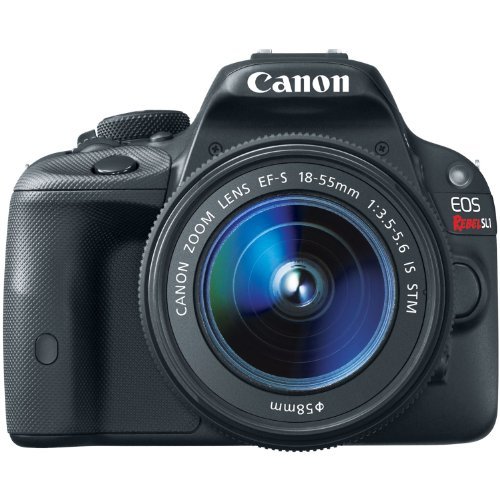
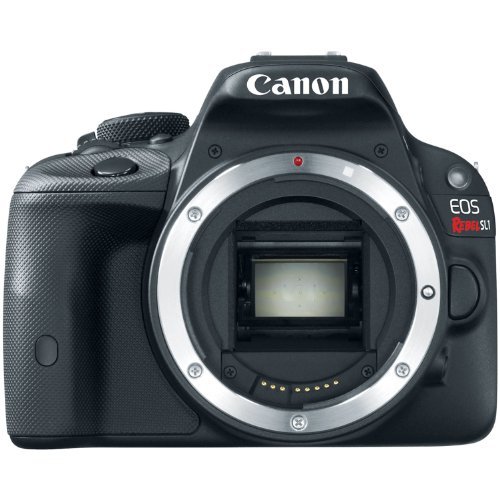
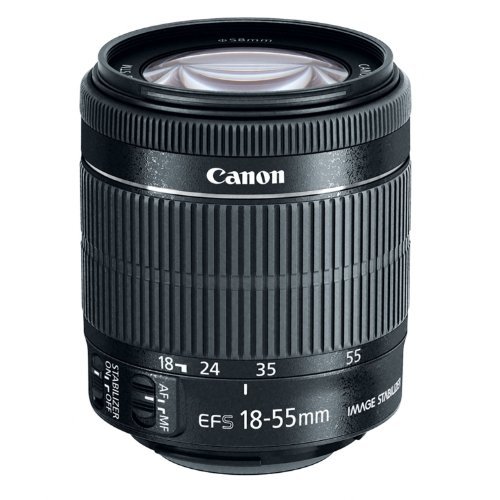
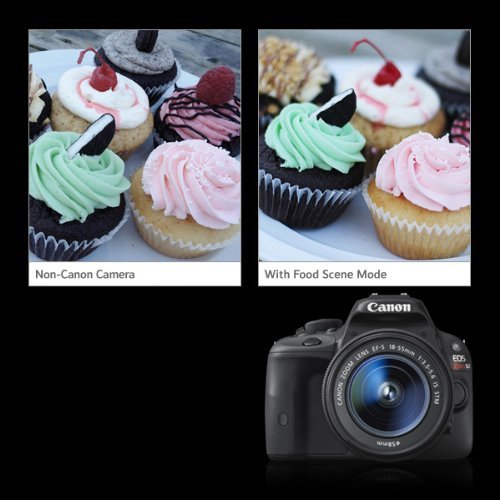
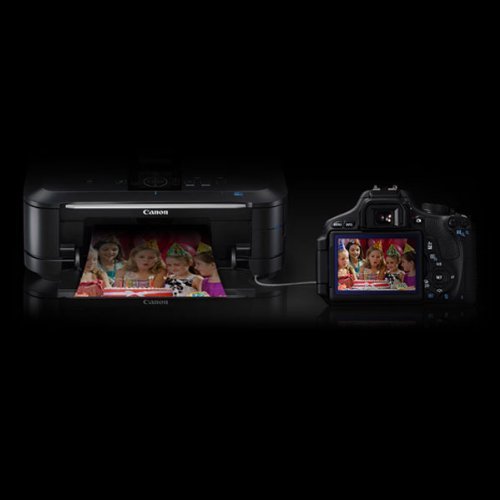
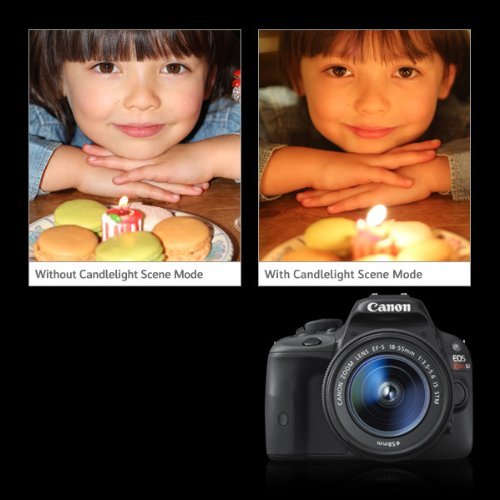






GPS compatible with the GP-E2 (sold separately)
Ignite Your Imagination
As the world’s smallest and lightest digital SLR*, the new EOS Rebel SL1 is small in size but enormous in performance. With a newly-designed Canon 18.0 Megapixel CMOS (APS-C) sensor and speedy Canon DIGIC 5 Image Processor, it delivers images of extraordinary quality – ideal for those stepping up from a smartphone or compact camera. An impressive ISO range of 100–12800 (expandable to H: 25600) for stills and 100–6400 (expandable to H: 12800) for video plus up to 4.0 fps continuous shooting make this camera the go-to for any photo opportunity, even in dim lighting or when capturing fast action subjects. And Hybrid CMOS AF II delivers accurate AF tracking during Live View shooting, helping ensure your photos and movies are crisp and clear. The EOS Rebel SL1 makes amazing movies with Canon EOS Full HD Movie Mode with Movie Servo AF, working in concert with Canon STM lenses for smooth and quiet continuous AF. In addition to its Optical Viewfinder, the EOS Rebel SL1 has a bright, wide Touch Screen 3.0” Clear View LCD monitor II, perfect for viewing a number of special scene modes and Creative Filters available in real-time display. Here is the DSLR you’ll want to bring with you everyday and ignite your imagination!
Amazing Capture and Processing Power, Astonishingly Compact.
World’s smallest and lightest digital SLR* For ultra portability with a minimal footprint, the EOS Rebel SL1 is the world’s smallest and lightest digital SLR*. Weighing in at approximately 13 ounces, the EOS Rebel SL1’s astonishingly compact size does not compromise its excellent performance as a member of the Canon EOS family: it features an 18.0 Megapixel CMOS (APS-C) sensor, the speedy DIGIC 5 Image Processor, a wide ISO range for both stills and video, and advanced AF performance. Designed for entry-level DSLR users, the EOS Rebel SL1 ensures performance and operation while still remaining compact.
18.0 Megapixel CMOS (APS-C) sensor The EOS Rebel SL1 features a newly-developed Canon 18.0 Megapixel CMOS (Complementary Metal Oxide Semiconductor) sensor in the world’s smallest and lightest digital SLR*. Perfect for enlargements or for cropping detailed portions of the composition, the camera’s sensor captures images with exceptional clarity and tonal range. This first-class sensor features many of the same technologies used by professional Canon cameras to maximize each pixel’s light-gathering efficiency and has center pixels that aid in the EOS Rebel SL1’s accurate AF performance. This APS-C size sensor creates an effective 1.6x field of view (compared to 35mm format).
ISO 100–12800 (expandable to H: 25600) for stills; ISO 100–6400 (expandable to H: 12800) for videos Thanks to its DIGIC 5 Image Processor, the EOS Rebel SL1 features an ISO range of ISO 100–12800 (expandable to H: 25600) for stills and ISO 100–6400 (expandable to H: 12800) for videos that makes shooting possible in situations previously unthinkable without flash. The EOS Rebel SL1, with the DIGIC 5 Image Processor’s remarkable noise-reduction technology, performs brilliantly in low-light shooting. Used with one of Canon’s EF or EF-S lenses with Optical Image Stabilizer, the EOS Rebel SL1 can record beautiful images and video even when light sources are scarce.
DIGIC 5 Image Processor The EOS Rebel SL1’s DIGIC 5 Image Processor works with the camera’s CMOS sensor to deliver images with incredible detail in more situations, without the need for artificial light sources. With the power of the DIGIC 5 Image Processor, the EOS Rebel SL1 can achieve higher ISO sensitivity, can shoot up to 4.0 fps continuously and can even perform advanced functions like displaying art filters in real time, new scene modes, lens correction and much more. The camera’s brilliant imaging core supercharges every facet of still and moving image capture.
Never Miss a Moment! High-speed continuous shooting The EOS Rebel SL1 can shoot up to 4.0 frames per second (fps) for up to approximately 7 consecutive RAW files or approximately 28 full-resolution JPEGs. Shooting at speeds of up to 1⁄4000 sec., the EOS Rebel SL1 can capture even rapidly unfolding scenes with ease.
True HD Performance, Rebel Simplicity.
EOS Full HD Movie Mode with Movie Servo AF The EOS Rebel SL1 offers easy-to-use, professional video capture without compromise. Capable of shooting in a number of recording sizes and frame rates, the EOS Rebel SL1 offers outstanding video capturing performance, quality and simplicity. The EOS Rebel SL1 enables easy manual control of exposure, focus and Live View features, even in-camera editing! Movie Servo AF allows continuous autofocus tracking of moving subjects while recording video. When shooting video with one of Canon’s STM lenses, Movie Servo AF takes advantage of the lens’ stepping motor for smooth and quiet continuous AF. With an STM lens attached, the EOS Rebel SL1 meets high standards for SLR moviemaking performance!
Resolution & Recording Sizes Frame Rates Full HD 1920 x 1080 16:9 format 30 fps (29.97) 25 fps – PAL standard 24 fps (23.976) HD 1280 x 720 16:9 format 60 fps (59.94) 50 fps – PAL standard Standard Definition (SD) 640 x 480 30 fps (29.97) 25 fps – PAL standard Built-in monaural microphone, manual audio level adjustment The EOS Rebel SL1 has an internal monaural microphone for audio capture and a wind filter feature to reduce wind noise when shooting outdoors. Sound recording levels can be manually (up to 64 different levels) or automatically controlled. A built-in attenuator is also provided to reduce audio clipping. For more advanced audio recording, the EOS Rebel SL1 is compatible with many third-party electret condenser microphones with a 3.5mm diameter plug.
Video Snapshot With the Video Snapshot feature, the EOS Rebel SL1 can capture short video clips (of 2, 4 or 8 seconds) then combine them automatically into one video file as a snapshot or highlights “album”. With no editing needed after shooting, the compiled video is perfect for sharing online or displaying directly on an HDTV via the camera’s HDMI port. Additionally, stills can be recorded during video shooting simply by pressing the camera’s shutter button. During playback, video clips in an album can be reordered or deleted.
Multi-touch, Brilliant View. Touch Screen Wide 3.0-inch Clear View LCD monitor II with multi-touch operation and Touch AF Using capacitive touch screen technology similar to today’s popular mobile devices, the EOS Rebel SL1’s gorgeous LCD monitor is touch-sensitive, delivering intuitive operation with ease. Two-finger touch gestures can be used for zooming or changing images. Menu and quick control settings can be accessed, and focus point and shutter release can be activated with the touch of a fingertip using Touch AF. Displaying fine detail (at approximately 1.04 million dots), the camera’s Touch Screen Wide 3.0-inch Clear View LCD monitor II is perfect for composing and reviewing images. Thanks to a new, solid construction between the monitor’s resin-coated cover and the liquid crystal display, reflections are minimized, and the display can be viewed, without glare, from any number of angles. The LCD’s surface is treated with a smudge-resistant coating to minimize fingerprints and to maintain a bright, clear image display.
Optical Viewfinder with approx. 0.87x magnification In addition to its amazing multi-touch screen, the EOS Rebel SL1 also sports an Optical Viewfinder, ideal for composing shots when shooting in bright conditions or capturing the moment as it unfolds. Shooting with the Optical Viewfinder also ensures steadier images. The viewfinder displays exposure, AF, flash, plus other relevant image information right along with the image. The 0.87x magnification factor ensures that subjects are easier to find and track.
Innovative AF Solutions for Consistently Excellent Performance. 9-point AF system (including a high-precision dual-cross f/2.8 center point) When shooting through the viewfinder, the EOS Rebel SL1 has exceptional autofocus with a sophisticated 9-point AF system, including a high-precision dual-cross f/2.8 center point, for accurate focus whether the camera is oriented in portrait or landscape position. A proven AI Servo AF system achieves and maintains consistent focus with an exceptional degree of reliability.
Hybrid CMOS AF II Canon’s amazing Hybrid CMOS AF System is perfect for shooting photos and video in Live View. Combining two different kinds of AF – phase and contrast detection – and aided by pixels on the camera’s CMOS sensor that assist in predicting subject location, continuous focus tracking becomes faster and more accurate than ever before in Live View. And with the EOS Rebel SL1 you’ll get Hybrid CMOS AF II, which provides the same fantastic performance as the original but boasts an increased AF area that covers approximately 80% of the sensor for easier composition. This performance is enhanced further by Canon’s line of STM lenses, which provide smooth and quiet operation.
Complex Functions Made Simple. Scene Intelligent Auto mode The EOS Rebel SL1 features Scene Intelligent Auto mode, which incorporates a number of Canon technologies to deliver the best possible exposure. Joining Picture Style Auto, Automatic Lighting Optimizer, Automatic White Balance, Autofocus, and Automatic Exposure, Scene Intelligent Auto mode analyzes the image, accounting for faces, colors, brightness, moving objects, contrast, even whether the camera is handheld or on a tripod, and then chooses the exposure and enhancements that bring out the best in any scene or situation. Users without extensive photography knowledge or experience will not need to puzzle over settings; the Scene Intelligent Auto mode simplifies DSLR image capture so photographers can simply concentrate on composing images.
Creative Features, Amazing Images. Advanced Creative Filters that can be displayed in real time during Live View shooting Adding to the fun and creative possibilities available with the EOS Rebel SL1, the camera offers seven different creative filters for still images: Art Bold Effect, Water Painting Effect, Miniature Effect, Fisheye Effect, Grainy B/W, Soft Focus and Toy Camera Effect. Each effect can be applied in three different levels (low, standard and strong), and easily previewed on the LCD panel during Live View shooting. The EOS Rebel SL1 also features the new Miniature Effect for Movies. You will be amazed and delighted by the artistry that these creative filters will allow you to create.
Effect Shot mode and Background Simulation Among the dynamic new features designed to make creative photography both intuitive and fun, the EOS Rebel SL1 has Background Simulation, which makes it easy for beginners to achieve dramatic blurred or sharpened backgrounds. The result is previewed on the LCD screen, so users can see in advance how their final image will look. Plus, a new Effect Shot feature automatically captures two shots simultaneously: one without effect, and one with a preselected Picture Style or Creative Filter effect. This makes it easy to see how each effect changes the photo without compromising the original image. Effect Shot mode is available in both Live View and viewfinder-based shooting, and can easily be viewed immediately in playback mode.
The Right Mode for the Right Situation.
New Special Scene Modes: Kids, Food and Candlelight The EOS Rebel SL1 has three new easily accessible scene modes to capture the perfect image the first time. Kids mode ensures high-speed shutter priority, focus tracking, healthy skin tones and flash when needed; Food mode delivers bright, vivid food images, limits flash by default and limits the red tint often associated with “restaurant plate” photography. With Candlelight mode, the camera will take care not to blow out the scene, maintaining the glow of the candle, leaving the flash off and reducing exposure fluctuation.
Flexible and Reliable Recording. Compatibility with SD/SDHC/SDXC memory cards, including Ultra High Speed cards The EOS Rebel SL1 uses popular SD, SDHC, SDXC, and is even compatible with Ultra High Speed (UHS-I), memory cards. Compact and available in large capacities, SD, SDHC and SDXC memory cards are a perfect complement to the camera’s compact design.
Additionally, the EOS Rebel SL1 is compatible with Eye-Fi* SD cards, which are outfitted with a Wi-Fi® transmitter (IEEE 802.11b/g) and an internal antenna for wireless, high-speed transfer of images. With an Eye-Fi card installed, the EOS Rebel SL1 can display the Eye-Fi’s connection status and error notes with ease, for fully functional wireless uploading of images directly from the camera.
A Comprehensive System of Optics Perfect For Video and Stills. Compatible with EF and EF-S lenses The EOS Rebel SL1 is compatible with all Canon lenses in the EF lineup, including compact and lightweight EF-S lenses, ranging from ultra-wide angle to super telephoto lenses and including the STM series, like the new EF-S 18–55mm f/3.5–5.6 IS STM, optimized for video shooting. Canon lenses employ advanced optical expertise and micron-precision engineering to deliver outstanding performance and deliver beautiful results. Special technologies like Canon’s Optical Image Stabilizer help to minimize the effect of camera shake, effectively adding up to four stops of light; STM lenses even feature a stepping motor for smooth and quiet continuous autofocus while capturing video. With an array of lenses perfect for travel, sports, still life and everything in between, photographers can truly maximize the quality and performance of their EOS Rebel SL1.
More Features for Increased Versatility. Lens Aberration Correction The EOS Rebel SL1 features lens correction tools that compensate for lens characteristics that can affect overall image quality. The EOS Rebel SL1’s lens peripheral illumination correction feature corrects light falloff in the corner of the image according to the characteristics of the lens being used. It even has correction data for a number of popular lenses stored in its memory. With the EOS Rebel SL1’s chromatic aberration correction tool, distracting color fringing can be corrected at the time of shooting.
Feature Guide To help explain the specific function of features found on the EOS Rebel SL1, the Feature Guide displays a simple description helpful in determining the applicability for the situation at hand. It is displayed in each shooting mode, during mode dial operations, and for Quick Control screen functions. It appears automatically when a function is selected – a lifesaver when trying to determine the best mode or function for the next picture. The feature guide works automatically by default, and can be disabled easily through the camera’s menu.
GPS Compatible With the optional GPS Receiver GP-E2 attached to the hot shoe or the digital terminal, the EOS Rebel SL1 can record location, including latitude, longitude and altitude, and has the ability to track the trajectory of movement with its logging function. An electric compass records the camera’s orientation during each shot, and world time information is recorded through GPS syncing.
JPEG Resizing To create images suitable for sharing by email or online, the EOS Rebel SL1 can resize JPEG files, in-camera, of varying pixels (aspect ratio cannot be changed, only the image size can be decreased) while leaving the original image untouched.
Photobook Set-up Photographers can share their images in book form with the EOS Rebel SL1’s convenient Photobook Set-up feature. Users can easily choose specific images, images in a folder and even all images, then specify their sequence and layout. The results can be printed in book form with ease.
Image Rating To help organize images recorded to the camera’s storage, the EOS Rebel SL1 makes it simple to rate individual images from one star to five. Therefore, image browsing, printing and slide shows can be based upon those ratings.
Cropping Eliminating the need to post-process in the computer, photographers can easily crop their photos right in the EOS Rebel SL1. Perfect for direct connection to a printer, or in situations when it wasn’t possible to zoom in enough with a zoom lens, cropping is a viable solution thanks to the camera’s excellent 18.0-megapixel resolution. Users can choose vertical or horizontal images, and 3:2, 4:3, 16:9, even 1:1 aspect ratios.
Im a casual photographer, who travels a lot and wanted a SLR to take with me. I also want to enhance my photography as a hobby, although I don’t plan on ever being professional. I’ve owned several compact digital prior to this camera.Size:Even though I knew what I was ordering, I couldn’t get over the size. It’s so small for an SLR and so lightweight. I’ve checked multiple times because I didn’t think it was loaded in my bag, it felt empty. No kidding, it’s that light weight. But still has all the buttons you need, well placed and easy to operate. It also feels tough and durable, so don’t be dissuaded by the light weight or small size. I’m not sure about the concern some voiced about it being “too small” to hold. It’s very comfortable. If you are going to shoot for 2 hours straight and/or have shot with a larger camera for 5 years, then maybe this would take some getting used to. But it’s very easy to manage, comfortable to hold and feels solid in my hand.Performance:I’ve been experimenting for a couple months now with various settings, different creative shots and I love the camera. Any failures are certainly mine as an amateur. It’s easy to shoot, fast enough (I’m not shooting for the NHL) and takes accurate, colorful pictures that are only limited by my creativity. I’ve shot macro, landscape, architecture, pets and portraits. I love it. It has a deep, feature rich set of custom options, menus and settings. I’m almost addicted to loading my amazing photos into a post photo software (name omitted) and playing with them to see how incredible they can get. That being said, they look incredible (when composed properly) straight from the RAW image. Also remember, this is a canon, so you can use virtually any lens ever created by them.Video:The improved AF Focus and STM lens is evident when shooting video. Video is amazingly clear, the AF does a good job keeping up with most subjects (again not shooting NHL or nocturnal animal scenery). The touchscreen, nearly silent lens combo is a huge improvement over prior versions. All but the most demanding professionals will find it does a remarkable job.Cons:Not many, seriously.No built in stereo mic..(minor issue use an external)No built in wifi (use an eye fi card)I kept this simple as there are some more technical reviews out there. I thought simple usage from a consumer standpoint would be most helpful. My advice, be very careful hanging your hat on some of the Amazon reviews that are overly technical. Some of the reviewers don’t know as much as they pretend and quote erroneous facts, like the fact that this camera uses “contrast phase detect” for it’s auto focus. Wrong, older canon’s did, not this one. If you really need the technical details read a review by dpmag, dppreview, camera labs etc. They will be spot on accurate and not a pseudo professional opinion. Happy hunting…If you found this helpful, please click yes! Thank you.
This is a very compact DSLR similar in ability and layout to a Rebel T2i/T3i for stills. Enhanced autofocus has made it Canon’s best DSLR for point-and-shoot style movies (superseded by the 70D in 2014). Paired with small primes, it makes for an exceedingly capable travel camera. Larger kits can make the T5i preferable. Smaller kits come more readily from mirrorless cameras with smaller senors.==== Rebel T5i:18 MP5 fps9-point AF w/ 9 cross pointsHybrid AF w/ 9% frame coverage1080p/30, 720p/60Articulating touchscreenStereo mics13m flash range20 oz==== Rebel SL1:+ 14 oz, 30% smaller by volume+ Hybrid AF w/ 64% frame coverage– 4 fps– fixed touchscreen– 9 point AF w/ 1 cross point– 9.4m flash range– mono micDIFFERENCES:* Size.This is the smallest DSLR from any make. It’s a whole size tier below the T5i and level with a number of mirrorless bodies. Whether that’s a worthwhile ergonomic compromise depends on the use case. With a small lens like a 40⁄2.8, the combined package reduces to prosumer point-and-shoot dimensions. Anything more ample (even the kit 18-55) and the bulk of the lens rapidly offsets the SL1’s space efficiency.In-hand, the SL1 is a fingertip camera. The palm of my large right hand doesn’t rest easily against the body without finger contortions, so support comes mostly from the left under the lens. It feels (and looks) lilliputian if you’re used to larger DSLRs, but that’s the only real adjustment; the button layout has no surprises relative to the T2/3/4/5i.* Single cross-point AF.First, context: Canon uses autofocus to differentiate between DSLRs. More expensive cameras tend to have ‘better’ autofocus. Precisely what that means, and whether it matters, depends on your requirements. With the addition of movie capability, we’ve got three parameters to consider: stills with static subjects, stills with movement, and movies with movement. A complicating factor is that performance depends greatly on whether you’re shooting through the viewfinder or from the rear LCD (“Live View”). Unlike point-and-shoot and mirrorless bodies, Canon DSLRs (and all others save Sony’s) have two entirely separate autofocus systems.When I talk about ‘phase-detect’ AF and ‘cross-points’, these are characteristics of the viewfinder AF system. The SL1’s phase-detect AF array has 9 points. Only the center point is a cross-point. Cross-points (shaped like a +) detect contrast in any orientation. The 8 outer points (shaped like lines) only see contrast that’s near perpendicular to them. The practical implication is that the T4i/T5i will be somewhat faster and more consistent with off-center compositions with wide-aperture lenses (e.g., 50⁄1.8) and motion-tracking.Both systems outperform the contrast-detect focus in any current mirrorless body with motion. You focus through an optical viewfinder that’ll never wash out, show noise in dim lighting, lag the action, or smear colors. In exchange, you lose the clever information overlays of electronic viewfinders (EVF), the face tracking that’s become a part of many contrast-detect systems, and the precise matching between what the EVF shows and the camera records.Here’s the phase-detect breakdown for this body:VF, stills, static: fast and accurate in frame-centerVF, stills, movement: moderately fast and accurate in frame-centerVF, movies, any subject: not possibleThis is the same AF array as in the T2i/T3i. If you were happy with those bodies, you’ll be equally so with this one.* Hybrid AF II.In the T3i and prior, Live View focusing from the rear LCD was achieved by contrast-detect. This method is vastly slower than phase-detect and, in Canon’s DSLR implementation, isn’t capable of tracking motion in movies. It’s reasonably quick and quite accurate with stills. It isn’t possible to use the main phase-detect array without interrupting Live View because a mirror gets in the way.The T4i/T5i added a second phase-detect system integrated into the imaging sensor itself that boosted acquisition speed and improved motion tracking to mediocre/adequate levels, but only for the center 9% of the frame. The SL1 expands this system to 64% frame coverage. The result is significantly more confidence with continuous autofocus in movies. With off-center subjects, it hunts (bringing the scene in and out of focus) much less than the T4i/T5i.Here’s the contrast-detect breakdown:LV, stills, static: reasonably fast and accurate over the whole frameLV, stills, movement: slow, accurate when it can keep upLV, movies, static: reasonably fast, occasional huntingLV, movies, movement: slow, accurate when it can keep upMotion tracking is still short of exceptional. STM lenses (which use a stepper motor instead of standard USM or a noisy micro-motor) work more quickly and precisely than non-STM lenses. They’ll track slow, undemanding subjects and faces. For more challenging movement, either prefocus, manually focus, or jump to the next performance tier comprised of Sony’s ‘translucent mirror’ DSLRs, many mirrorless bodies (e.g., Panasonic G/GH), and Canon’s own 70D. The SL1 has no focusing aids (e.g., focus peaking) for Live View except full-screen zoom. Focusing accurately by hand on a moving target is very challenging.OTHERWISE:Everything else is to lesser consequence. A slightly weaker flash, a slightly slower framerate, a smaller battery, one less microphone channel. Even the loss of LCD articulation isn’t much of a bother unless you’re continually shooting from vantage points away from the viewfinder.A major advantage of the SL1 is that, like the T4i/T5i, it has a new touchscreen that that significantly lowers the EOS learning curve. It’s capacitive and almost as responsive as a modern smartphone. Adjusting functions (e.g., exposure, white balance, focus points; everything) is as simple as tapping what you want. The camera won’t be at the ready when you’re manipulating the LCD, but thanks in part to an integrated ‘feature guide’ that explains most options, you probably won’t need to pull out the manual on first acquaintance.Phone gestures (e.g., pinch zoom, swiping) are now part of the picture review system, which makes checking focus vastly quicker and more flexible than on any other non-touch EOS body. Focus itself is touch-enabled in Live View mode, so you can tap to focus on static subjects anywhere in the frame without ever having to manipulate the 9-point AF system.The interface isn’t necessarily intuitive, but photography in general isn’t intuitive. There’s a large gulf between a design for novice users that hides complication and one for experienced users that makes powerful features easily accessible. By offering redundant touch controls, Canon straddles this line surprisingly well. This is a camera that can grow with you.STILLS QUALITY:This sensor is functionally identical to those in the T2i/T3i/T4i/T5i/60D/7D save for the pixels devoted to phase-detect. Noise and dynamic range are similar in raw. Expect acceptable results up to ISO 3200. Nikon’s D5100 is slightly better, Sony’s A65 slightly worse. It’s about two solid stops better than a typical point-and-shoot.Unless you’re in a JPEG-only shooting mode (e.g., multi-shot NR, HDR), raw gets the most out of this camera. JPEG often lacks the flexibility for significant changes in post. Raw shooting also lets you defer decisions (e.g., white balance, sharpening, noise reduction, color, lens corrections, tone curves, and even exposure) that distract from catching whatever moment you’re after.That aside, if your scene and shooting technique don’t call for major adjustments on the computer, you’re likely to be pleased with the JPEG output.LENSES:The 18-55⁄3.5-5.6 STM is a stellar optic. Focus is as fast as the camera allows, near-silent, and inaudible in movies, as is the IS system. If you upgrade, it’ll be for speed, a different range, or perhaps more contrast, not because it isn’t sharp enough. The 18-135⁄3.5-5.6 STM is equally impressive, though about an inch longer and twice the weight.Light and small primes are well-suited to this body. The 40⁄2.8 STM, 50⁄1.8, 28⁄1.8, and 28⁄2.8 are all more compact than the kit lens. Larger lenses work as with any other EOS body, though some will be slightly more awkward when you’re trying to adjust the zoom ring and support the rig from under the lens at the same time.ACCESSORIES:For video, buy SD cards 32 GB or larger. My pair of 16 GB cards have been inadequate for even a one-day event. The highest recording quality uses 350 MB/minute, equating to about 90 minutes per 32 GB card. For stills (~7 MB in JPEG and ~25 MB in raw), two or three 8 GB cards is plenty.Interface responsiveness isn’t much affected by card speed. Faster cards have three advantages: they can shoot longer bursts at 4 FPS, clear the picture buffer more quickly, and record video at the highest quality without risking a speed warning. Buffer depth is 28 JPEGs and 7 raw files with a standard SD card. Buffer cycling times are much lower with UHS-1 (‘Ultra High Speed’). In one-shot mode, this difference is invisible; very fast cards would only make sense if you were time-limited on card-to-computer transfers with a USB 3.0, SATA, or Firewire card reader.If you buy protection filters for your lenses, try Hoya’s “DMC PRO1 Clear Protector Digital” line. They have very high light transmission and cause no visible flare. Digital sensors filter UV natively, there’s no reason to pay more for that feature. I’ve written reviews on the relevant Hoya product pages with more details and why you might (or might not) want a filter.IN SUM:Whether this DSLR is your huckleberry depends on your priorities. This is new territory for Canon. The SL1 is sized to compete with mirrorless, but the EOS lens line doesn’t have many compact options to pair with it. And it never will, because the SL1 uses an APS-C sensor, the second-largest available. That applies doubly for Canon’s mirrorless EOS-M, which looks like a deck of cards beneath an Evian bottle when attached to any of the f/2.8 zooms or longer telephotos.Canon’s lens line is simultaneously the greatest strength and weakness of this body. The EOS mount makes accessible some extraordinary and unique high-dollar glass. If you want to shoot supertelephotos, or real tilt-shift, or superfast primes that see in the dark, or macro lenses that’ll fill the frame with Roosevelt’s head on a dime, there’s no other system that has it all under one umbrella. And if you’ve already invested in it, the SL1 is the obvious choice.But what if that’s not you? What if you plan to stay with the general-purpose lenses that just about every system contains? The advantages of the SL1 narrow considerably. They are: subject isolation, motion tracking with stills, the immediacy of an optical viewfinder, and Canon’s highly polished user interface.Relative to a M4/3s body like Panasonic’s G6, the SL1 will have more foreground and background blur at any given aperture. If you’re all about creamy backgrounds for portraiture, the difference is noticeable. You can still isolate with M4/3s, it just takes a closer subject and more telephoto.Motion tracking for stills used to be a huge arrow in the SL1’s quiver. It still is relative to most mirrorless bodies, though recent ones have gotten surprisingly fast. Likewise for low-light focusing, formerly a mirrorless weakness. Still, if your subjects are often running children, or anything that moves toward or away from you at high speed, the SL1 will have a higher hit-rate.The optical viewfinder is a double-edged sword. On the one hand, you’re seeing the scene in real-time with no processing delays from imaging hardware. On the other, you’re not seeing what the camera sees. The DSLR shooting process involves a lot of chimping, where you take the shot with the viewfinder and immediately check the exposure with the rear LCD. Not so with mirrorless: what you see is what you get, for better or worse. The SL1 finder maintains an edge with fast action and in very dark conditions that’ll cause OLED/LCD viewfinders to fade to black.And then we have Canon’s UI. They’ve polished it for thirty years and the effort shows, particularly relative to recent entrants like Sony’s NEX line. But Panasonic and others are closing the gap. This SL1 isn’t the only camera with a touchscreen and logical menus. More to the point, mirrorless bodies are often less clunky than the strange amalgam of ‘Live View’ and traditional mirror shooting that defines this camera and other DSLRs. That may well consume the SL1’s advantage.So what conclusions?If you’re all about small size and you can sacrifice the SL1’s advantages, mirrorless is where you want to be. The Olympus OM-series leads the pack now in this price range. Tomorrow, the leader may be something else.If you want to pair this body with fast, high-dollar EOS lenses or bulky accessories like an external flash, the T5i is a better alternative. The cost difference disappears into the system cost. The SL1 maintains an advantage with continuous focus in movie-mode, but lags everywhere else.If you want the smallest possible EOS-compatible body, the EOS-M has identical image quality in a truly miniature package. After a recent firmware update, it’s now acceptably fast at focusing, though still well behind the SL1 in general responsiveness.But if your priorities favor DSLRs, hands-off autofocus in movies, and small size, the SL1 is the best choice in Canon’s arsenal. A compromise, yes, but a good one.
Delivered in great condition! It also came earlier than expected. I love it so much, I really do recommend it!
This is a great camera for beginners, I love the size and weight of this camera. I’m planning to keep this camera for a long time!
Not satisfied
Love it!!!!!
Packaging was excellent, Everything came as expected and there were no issues.
Its really worthy and good
This camera is amazing! I bought it used- like New for a small discount. It’s a fantastic camera I originally bought it for YouTube but it’s amazing for all uses.
Perfect. :) 100⁄100
Great product fashion shipping
comments powered by DisqusGreat price looks and works like new. Timely shipping packages great. Would purchase again.